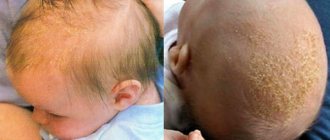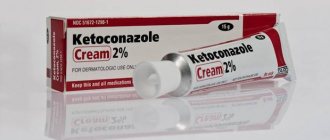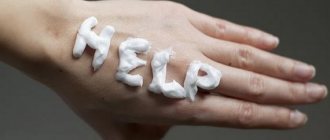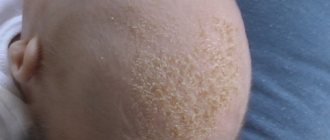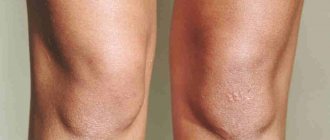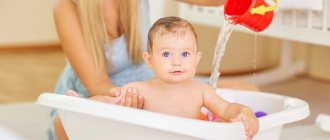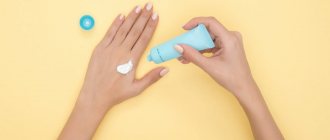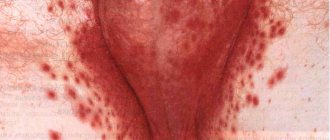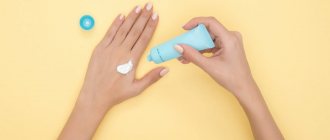05/27/2021 Reading time: 5 min 18204 0
By the end of the first month of life or a little later, yellowish crusty scales can be noticed on the baby’s scalp. They can frighten and upset a mother who is unprepared for such a phenomenon, but meanwhile there is nothing terrible about them. Milk crusts, which actually have nothing to do with milk, occur in many children under one year old. In medical terminology, they are called seborrheic dermatitis, physiological seborrhea or gneiss.
Peeling in newborns - how it manifests itself
Do you notice that the skin on your newborn’s body is peeling? There is no need to panic because of this; in most infants, peeling is physiological in nature and is associated with the maturation of the skin, as well as with adaptation to the external environment.
On the 3-4th day of life, thin whitish films can be seen on the baby’s body. If you easily run your finger over the baby’s body, these films begin to roll off. Because a newborn's epidermis is very sensitive, redness and peeling may occur where it is touched (for example, on the chin, nose, or between the eyebrows). You may find crusts on your head. They can be dense or not very dense, yellow or white, tightly adjacent to the skin. Often these crusts come off after bathing. In most newborns, the skin peeling looks like small flakes. During bathing, they are removed, leaving no red marks in their place. If you notice peeling skin and crusts on your baby’s head, do not try to specifically remove them. A baby's skin is very delicate, vulnerable, with a large number of blood vessels. Even a small scratch on the skin can lead to infection and cause inflammation. In some cases, an infectious process is hidden behind peeling skin. You can suspect it by carefully examining the problem area of the baby’s body. You should consult your doctor if:
- liquid and pus are released from under the crust;
- pustules appear;
- redness appears around the problem area;
- the baby becomes restless, cries often and loudly;
- his body temperature rises.
Peeling that does not go away after bathing and gets worse over time requires special attention. We recommend consulting a pediatrician or dermatologist.
Is it necessary to remove crusts from a baby's head?
If an infection gets into the skin, it is necessary to use antifungal ointments.
The crusts, as a rule, go away on their own by one year, so there is no need to do anything to eliminate them. According to pediatrician Komarovsky, measures should be taken in the following cases:
- suppuration forms;
- an unpleasant odor appears;
- a weeping surface is formed with the release of ichor;
- there is redness and swelling around the crust.
These symptoms indicate that an infection has penetrated the skin. These cases require contacting a clinic.
Why does my baby's skin peel?
At 2-3 weeks of life, most babies experience a state of physiological erythema, in which the skin acquires a reddish tint and then begins to peel off. If you do not notice any changes in your baby's behavior, then there is no need to worry. It is worth paying special attention to peeling skin if it gives way to redness on the baby’s cheeks, head, arms and legs, and then small blisters appear. The cause of this peeling is an allergic reaction (atopic dermatitis). With such peeling, the child is very restless, capricious, and is tormented by itching. Allergies can be caused by products used to wash children's clothes, by a nursing mother eating foods to which the baby's body is sensitive, or by an inappropriate formula if the baby is bottle-fed.
Peeling can also be caused by other reasons:
- too warm and dry air - low humidity and high air temperature in the child’s room can cause dry skin and the appearance of crusts in the nose;
- improper care - using potassium permanganate, toilet soap or other inappropriate hygiene products, bathing in too warm (temperatures above 37 degrees) or hard water can cause peeling of the child’s skin;
- cold air - baby’s skin is very sensitive to temperature changes. If parents walk with their child in frosty and windy weather in winter, or in hot summer weather, the skin may react with peeling.
Symptoms of peeling skin
When the skin peels, you can most often notice roughness on the baby's back. If the cause of peeling is dry or hot air, then most often it is accompanied by swelling of the skin and its wrinkling. When the baby's delicate skin rubs against clothing, peeling may also occur. In this case, most often the roughness appears on the baby’s chin or neck. Depending on the cause, peeling may be localized on different parts of the body, and the size of the affected areas of skin may also differ.
The skin on the body is peeling
Foci of peeling on the legs, arms, and torso often occur in children born after 38 weeks. The reason is prolonged exposure to amniotic fluid. The peeling process in such babies is not localized in one place and can be observed throughout the body. If you observe that the peeling intensifies after bathing, most likely you are using inappropriate products for washing your child (potassium permanganate, aggressive detergents not intended for children's skin).
All bath products in the Mustela range are created specifically for the delicate skin of children. They contain soft surfactants that gently cleanse the skin without drying it out. Suitable for use from the first days of life.
Choose Mustela skin cleansing and bathing
The skin on the head is peeling
In the first month of life in babies, peeling is most often observed in the area of skin folds behind the ears, on the eyebrows. It is in these places that the baby's skin is especially thin and sensitive. It is recommended to carefully care for it, otherwise it may become inflamed and reddened. The appearance of peeling on the child’s cheeks, forehead, and chin may be the first sign of atopic dermatitis. Crusts on the scalp are another form of flaking that is often a precursor to atopy.
Shampoo-mousse “STELATOPIA” gently cleanses and soothes the baby’s scalp,
Reduces dry skin by 93% (1)
Peeling skin on legs and arms
Starting from the face, peeling can move to the scalp, and then spread to the area of joints, skin folds, and the bends of the arms and legs. Most often, this situation is caused by atopic dermatitis. With atopy, the areas of peeling are initially small in size, then swell, turn red, and small bubbles filled with liquid appear in them. They cause great concern to the child and constantly itch.
Emollient cream “STELATOPIA” eliminates the feeling of discomfort, tightness and itching in 80% of cases (2)
Causes of seborrheic dermatitis in adolescents
As mentioned above, the causative agent of dermatitis is a fungus. However, it does not begin to multiply and function too actively without any reason. It becomes overly active only when the balance in the body is disturbed, the reasons for which are the following factors:
- puberty;
- heredity, genetic predisposition;
- disturbances in the functioning of the gonads, adrenal glands, pituitary gland, thyroid gland;
- disruption of the endocrine system, which disrupts the production of sebum;
- severe nervous tension, stressful situations;
- poor nutrition, lack of vitamins, as well as disturbances in the gastrointestinal tract;
- incorrect mode: lack of sleep, lack of walks and physical activity, sedentary lifestyle.
Only a doctor can determine the exact cause of dermatitis, especially if it lies in disturbances in the functioning of internal organs or systems. The doctor will order tests and examinations, make a diagnosis and prescribe treatment. But before visiting a doctor, you can analyze your health status, evaluate your lifestyle and guess the main reason. Often, normalizing your lifestyle allows you, if not to get rid of seborrheic dermatitis, then at least to slightly improve the condition of the skin.
What helps improve the condition of a child's skin?
If you notice that your baby has signs of peeling skin, but the child is feeling well, then there is no need to panic. Within a few days, the baby's skin will adapt to environmental conditions and become smooth to the touch. If the child is restless, and the areas of peeling increase, acquire a reddish tint and spread throughout the body, do not postpone a visit to the pediatrician. Even before consulting a doctor, you can independently analyze the situation and eliminate possible causes that could cause a problem with the newborn’s skin:
- Insufficient air humidity
Maintain the humidity in the baby's room at 50-70%. This can be done by using a humidifier or damp towels to cover the central heating radiators;
- High temperature in the apartment
make sure that the temperature in the room where the newborn is located is in the range of 18-22 degrees;
- Aggressive detergents
refuse to use conventional detergents for washing and removing stains, and instead use hypoallergenic ones designed specifically for children’s clothes;
- Clothes made from synthetic fabrics
Choose clothes for your child made from natural fabrics that are pleasant to the body, highly breathable and absorb moisture. It should not contain rough elements that are in direct contact with the child’s body;
- Nutrition
if you suspect atopy, exclude all potentially allergenic foods from your diet (if you are breastfeeding your baby) or consult your doctor about choosing a different formula (if your baby is formula-fed);
- Exposure to weather conditions
When walking, protect your baby's skin from the bright sun and wind. Before going outside, lubricate your face with a protective product. Make sure that the baby is not in the sun for more than 5 minutes in the summer.
- Unsuitable care products
for bathing, use only warm water, preferably without adding potassium permanganate and infusion of string, do not use soap to wash the child more than once a week. Use gentle skin care products for your newborn.
Work on this problem at the Marina Ryabus clinic
A person who comes to a trichological appointment with complaints of itching and dry scalp will be comprehensively examined to develop the most effective treatment strategy. We will give you a phototrichogram - the method allows you to specifically study the condition of the hair follicles, hair, and scalp. The doctor will take a medical history, asking you questions about your eating habits, regularity of stress in your life, home care, etc. To form a complete picture, you will be sent for tests. We cooperate with the best laboratories in terms of diagnostic expertise. Tests can be taken on the day of your visit to the clinic. Please note that some tests require fasting blood donation. Based on the results of laboratory diagnostics, you will be offered an individual regimen for taking dietary supplements - vitamins, amino acids, minerals. The doctor will also give nutritional recommendations and select a line of care products for you (our partner is the professional cosmeceutical hair care brand Eliokap).
And, of course, procedures will be offered to you according to your indications. This could be mesotherapy with a cocktail rich in beneficial substances. It restores the healthy activity of the sebaceous glands, helps soothe the skin, and eliminates the problem of peeling and hair loss. To relieve inflammation around the hair follicles, improve hair growth and prevent alopecia, laser scalp treatment procedures are prescribed. At the Marina Ryabus clinic, these procedures are performed on the multifunctional Fotona SP Dynamis platform.
By following an individual treatment plan, you will definitely begin to notice how the quality of your skin and hair has improved. And, of course, the itching problem will be solved. If the doctors at the Marina Ryabus Clinic need to involve specialized specialists from other fields of medicine in the treatment (for example, if the itching is caused by allergies or nervous disorders), we will give you the necessary recommendations.
Marina Ryabus Clinic is a center for scientific cosmetology and anti-aging medicine. We will help you maintain beauty, health, activity and interest in life for as long as possible!
To make an appointment, call: +7 (499) 588-81-47;. You can also contact the clinic administrators on WhatsApp, Telegram, Viber by phone: +7 (925) 397-71-30. To receive a call back from the clinic, fill out the feedback form on the website.
Treatment and prevention of peeling
Properly organized child care helps to avoid skin problems and flaking.
- Use special products for daily hygiene and baby skin care. It is advisable that the products be tested by pediatricians and dermatologists.
- Moisturize your baby's skin every day before going for a walk, after washing and bathing.
- and humidity in your baby's room
- During walks, apply protective cream to exposed skin and cover your baby from the sun and wind.
- To wash your baby’s clothes and bedding, use only powders and other products that are labeled “for baby clothes.”
- Analyze your menu. Exclude from it all products that can cause allergies in your baby.
If you notice that peeling is causing your child anxiety, do not put off seeing a doctor for too long. The pediatrician will help you understand the cause of the discomfort, prescribe diagnostics if necessary, and recommend remedies to improve the condition of the skin.
Clinical study (self-reported results) conducted under the supervision of dermatologists and pediatricians over 21 days among 65 participants with atopic dermatitis. Clinical study (self-reported results) conducted under the supervision of dermatologists and pediatricians over 28 days among 65 participants with atopic skin.
Do I need to treat?
As we remember, a simple nevus is not a disease, which means it does not require treatment. Be patient and the stork spot will disappear on its own or at least become very pale. There are no creams, ointments or lotions that would speed up this process, so the doctor will not recommend anything to you other than observation. And it is strictly prohibited to use any medicines without a prescription, as well as traditional medicine recipes, when it comes to young children.
